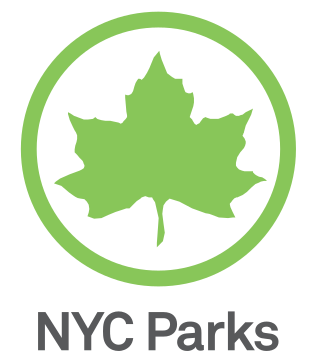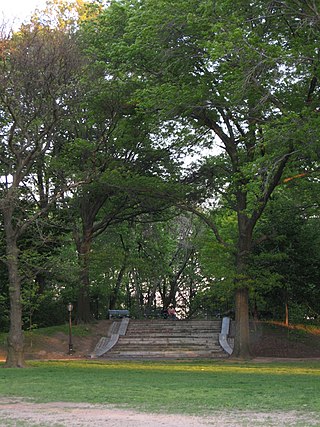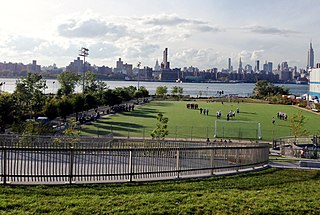Related Research Articles

The New York City Department of Parks and Recreation, also called the Parks Department or NYC Parks, is the department of the government of New York City responsible for maintaining the city's parks system, preserving and maintaining the ecological diversity of the city's natural areas, and furnishing recreational opportunities for city's residents and visitors.

Ridgewood Park, also known as Wallace's Ridgewood Park or the Wallace Grounds, and frequently confused with Grauer's Ridgewood Park, was a baseball ground in Ridgewood, Queens, New York. Both Wallace's and Grauer's are shown in Belcher Hyde's Map of Newtown in 1915. The baseball field was part of a larger entertainment area bounded Wyckoff Avenue, Covert Street, Halsey Street, and Irving Avenue. The baseball field was southwest of the Long Island Rail Road's Montauk Branch tracks. Eldert Street, although depicted on the map as running through the baseball grounds, was not cut through southwest of the railroad tracks and the road remains interrupted there today. Originally the park was in Queens County, before its incorporation into New York City in 1899. This facilitated Sunday baseball playing, including the charging of admission, beyond the reach of Sabbath enforcers from the then-city of Brooklyn.

Bedford–Stuyvesant, colloquially known as Bed–Stuy, is a neighborhood in the northern section of the New York City borough of Brooklyn. Bedford–Stuyvesant is bordered by Flushing Avenue to the north, Classon Avenue to the west, Broadway to the east, and Atlantic Avenue to the south. The main shopping street, Fulton Street runs east–west the length of the neighborhood and intersects high-traffic north–south streets including Bedford Avenue, Nostrand Avenue, and Stuyvesant Avenue. Bedford–Stuyvesant contains four smaller neighborhoods: Bedford, Stuyvesant Heights, Ocean Hill, and Weeksville. Part of Clinton Hill was once considered part of Bedford–Stuyvesant.

Mount Prospect Park is a 7.79-acre (3.15 ha) park in the central portion of the New York City borough of Brooklyn. It includes Mount Prospect, the second highest point in Brooklyn. It is located on Eastern Parkway near Underhill Avenue, close to Grand Army Plaza. The park is operated by the New York City Department of Parks and Recreation.

A community garden is a piece of land gardened or cultivated by a group of people individually or collectively. Normally in community gardens, the land is divided into individual plots. Each individual gardener is responsible for their own plot and the yielding or the production of which belongs to the individual. In collective gardens the piece of land is not divided. A group of people cultivate it together and the harvest belongs to all participants. Around the world, community gardens exist in various forms, it can be located in the proximity of neighborhoods or on balconies and rooftops. Its size can vary greatly from one to another.
The Trust for Public Land is a U.S. nonprofit organization with a mission to "create parks and protect land for people, ensuring healthy, livable communities for generations to come". Since its founding in 1972, the Trust for Public Land has completed 5,000 park-creation and land conservation projects across the United States, protected over 3 million acres, and helped pass more than 500 ballot measures—creating $70 billion in voter-approved public funding for parks and open spaces. The Trust for Public Land also researches and publishes authoritative data about parks, open space, conservation finance, and urban climate change adaptation. Headquartered in San Francisco, the organization is among the largest U.S. conservation nonprofits, with approximately 30 field offices across the U.S., including a federal affairs function in Washington, D.C.

The West Side Community Garden is a privately owned park in Manhattan, New York City, United States. It is located between West 89th Street and West 90th Street in the middle of the block between Amsterdam Avenue and Columbus Avenue.

Maria Hernandez Park is a municipal park in Bushwick, Brooklyn, New York City. It is located between Knickerbocker Avenue on the southwest to Irving Avenue on the northeast, and Starr Street on the northwest to Suydam Street on the southeast. The park is 6.87 acres (2.78 ha) and is near the Jefferson Street station of the New York City Subway.

Community gardens in the United States benefit both gardeners and society at large. Community gardens provide fresh produce to gardeners and their friends and neighbors. They provide a place of connection to nature and to other people. In a wider sense, community gardens provide green space, a habitat for insects and animals, sites for gardening education, and beautification of the local area. Community gardens provide access to land to those who otherwise could not have a garden, such as apartment-dwellers, the elderly, and the homeless. Many gardens resemble European allotment gardens, with plots or boxes where individuals and families can grow vegetables and flowers, including a number which began as victory gardens during World War II. Other gardens are worked as community farms with no individual plots at all, similar to urban farms.

The Brooklyn Heights Promenade, also called the Esplanade, is a 1,826-foot (557 m)-long platform and pedestrian walkway cantilevered over the Brooklyn-Queens Expressway in Brooklyn Heights, Brooklyn, New York City, United States. With views of Lower Manhattan's skyline and the New York Harbor, it came about as the byproduct of competing proposals for the highway's route that were resolved in the midst of World War II. Actual construction came after the war. As a structure built over a roadway, the Promenade is owned by the NYCDOT and is not considered a park; however, NYC Parks maintains the entire Promenade.
New York Sun Works, founded in 2004 by Ted Caplow, is a non-profit organization that uses hydroponic farming technology to educate students and teachers about the science of sustainability. To further this goal, NY Sun Works created the Greenhouse Project, an initiative dedicated to improving K through 12 grade environmental science education through the lens of urban agriculture, empowering children to make educated choices about their impact on the environment. The Greenhouse Project was inspired by NY Sun Works’ first project, the renowned Science Barge; a prototype, sustainable urban farm and environmental education center previously housed on the Hudson River and now located in Yonkers under different ownership.

Bushwick Inlet Park is a public park in the Williamsburg neighborhood of Brooklyn, New York City. The park currently consists of two non-contiguous sections along the East River and is eventually planned to reach into Greenpoint at Quay Street. The park is named for the nearby Bushwick Inlet, which it is planned to encompass upon completion.

Open Road Park is a small park in East Village, Manhattan, New York City, located east of First Avenue between 11th and 12th Streets. It is among the larger green spaces created in the East Village as a result of community organizing. The site of this park was taken over in 1993 by Open Road, a neighborhood nonprofit that developed the lot into a community garden and playground. Prior to its use as a park, the site was used for many purposes that reflect on the history of the surrounding neighborhood.

Stonewall National Monument is a 7.7-acre (3.1 ha) U.S. national monument in the West Village neighborhood of Greenwich Village in Lower Manhattan, New York City. The designated area includes the Stonewall Inn, the 0.19-acre (0.077 ha) Christopher Park, and nearby streets including Christopher Street, the site of the Stonewall riots of June 28, 1969, widely regarded as the start of the modern LGBT rights movement in the United States.
Taqwa Community Farm is a half-acre park operated as a community garden in the Highbridge neighborhood of the Bronx, New York City.
Community gardens in New York City are urban green spaces created and cared for by city residents who are stewards of underutilized land. There are over 550 community gardens on city property, over 745 school gardens, over 100 gardens in land trusts, and over 700 gardens at public housing developments throughout New York City.

The Concert Grove is a section of Prospect Park, Brooklyn, New York City, that historically functioned as an outdoor music venue. It still serves as a sculpture garden lined with busts of musical figures, largely put up by German American Sängerfest participants and other cultural groups. The Concert Grove also includes the Concert Grove Pavilion, formerly known as the Oriental Pavilion, and adjoins a Lincoln sculpture facing the lake.
The Bedford Union Armory is a historic National Guard armory building located in the Crown Heights neighborhood of Brooklyn, New York City. It is a brick and stone castle-like structure built in 1903 and opened in 1908 and was used by the U.S. Army for training, equipment storage and even as a horse stable. The current community center opened in October 2021.

Maple Street Community Garden is a community garden in the Prospect Lefferts Gardens neighborhood of Brooklyn, New York City. It is located on Maple Street between Jean-Jacques Dessalines Boulevard and Nostrand Avenue.
The Green Guerillas are a community group of horticulturalists, gardeners, botanists, and planners who work to turn abandoned or empty spaces in New York City into gardens. Formed in the 1970s, the group threw "seed grenades" into derelict lots and developed community gardens, often without going through official channels. It became especially popular after the concerted redevelopment of a dangerous, trash-filled space at the corner of Houston Street and Bowery in Manhattan. The resulting press coverage and word of mouth led the group to broaden its activities from active gardening to education, training, and support for a number of community groups working on their own gardens. The Green Guerillas have been credited with beginning the community garden movement and popularizing the idea of guerilla gardening.
References
- 1 2 3 "Growing on Vacant Brooklyn Lots, Reclaiming Public Space". MetroFocus. 2012-05-16. Retrieved 2021-05-03.
- 1 2 3 Kavanaugh, Marialexa (2020-06-25). "Behind Closed Gates, Brooklyn Community Gardens Continue to Plant Seeds of Change". Bedford + Bowery. Retrieved 2021-05-03.
- ↑ Weber, Christopher (2013-10-15). "Pretty vacants: Urban communities fill empty lots with gardens, skate parks, and creative possibility". Grist. Retrieved 2021-05-03.
- ↑ Bryce, Emma (2012-10-17). "After a Year of Adoptions, Orphaned Lots Bloom". Green Blog. Retrieved 2021-05-05.
- 1 2 Quale, Brittany (2017-06-01). "Creating a Sustainable Community Garden". Parks and Recreation Magazine. National Recreation and Park Association. Retrieved 2021-05-03.
- ↑ Cohen, Li Yakira (2019-07-17). "Immigration policy protests are being held at more than a dozen farms and gardens". am New York. Retrieved 2021-05-03.
- ↑ Deep, Brooklyn (2015-07-15). "Bed-Stuy is Focus of Concerns Over Fate of Community Gardens". City Limits. Retrieved 2021-05-03.
- ↑ Rosengren, Cole (2016-01-04). "Brooklyn Community Gardeners React to De Blasio Admin. Deal". City Limits. Retrieved 2021-05-05.